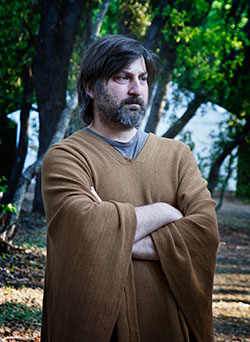Smiljan Radic’s Serpentine Pavilion

Roula Khalaf, Editor of the FT, selects her favourite stories in this weekly newsletter.
It’s a bagel, or perhaps a doughnut. Or an egg shell. Maybe a UFO. Anyway it’s resting on massive rocks. Inspired, naturally, by Oscar Wilde’s “The Selfish Giant”. It’s translucent, it’ll glow in the dark. Apparently. It’s made of something like papier-mâché – you know, those balloon heads you made with the kids? But the balloon has deflated. Oh, and it was conceived as a garden folly in the English tradition. This year’s Serpentine Pavilion is not short of metaphors.

Its architect is Chilean Smiljan Radic, a relative unknown compared with his celebrity forebears on the job (Zaha Hadid, Rem Koolhaas, Frank Gehry, Oscar Niemeyer, Herzog & De Meuron and the others). And just like Radic’s other buildings so far, it really is very odd.
The Serpentine has been challenging architects who haven’t built in the UK before to build provocative pavilions in Kensington Gardens for a decade and a half and, most of the time, they’ve been doing a pretty good job of it. The pavilion has become a quintessential part of the London summer scene, one of the rare moments when architecture is presented, unmediated, to a public who seem consistently – and increasingly – interested.
Last year’s pavilion – an ethereal assembly of white steel bars to create a diffuse grid, by the Japanese architect Sou Fujimoto – was a real delight, a thing that appeared so light it seemed like some kind of pixelated cloud. Radic’s attempt is something very different. The site is strewn with chunky limestone rocks quarried near Bradford (which chime delightfully with Fischli and Weiss’s striking nearby sculpture, “Rock on Top of Another Rock”) and upon these is placed a very strange object, that hollow bagel.
The shell is built up of consecutive layers of glass-reinforced plastic mesh in a process very similar to papier mâché; it even has the coarse, handmade quality familiar from those layers of newspaper and paste. Rather unnervingly for such a large structure, it has no armature or frame. The construction technique is borrowed from boat building but this is, apparently, the first time it has been applied to a building at this scale.
In places it looks like the shell has been torn away to make irregular openings. Long ramps rise gradually from the lawn to the interior, which enhances the UFO effect of an object that has apparently landed here from God knows where.
The interior is curious. Something between a yurt, a Portaloo, a marquee and a paper lantern, it is a very odd hybrid with a rather calming effect. The hole in the centre becomes a solid core so that it is like being inside a large translucent tyre, which, it turns out, is actually a good thing.

The ripped-open surface gives glimpses of the park beyond and a sculptural steel scoop penetrates the sheet at one point to create an incongruous window. The architect claims that he was inspired by Oscar Wilde’s “The Selfish Giant” to create a place that appears as if it has been neglected and has suddenly opened up to the world again. Frankly, I don’t really see it. But that’s OK.
Radic, who looks a little like a youthful Slavoj Zizek, is interested in a sense of the primitive. His projects work through startling juxtaposition, of clinical modernity with a menhir-like boulder, say, or through a kind of surrealism that takes in the temporary, from circus tents to market stalls, but ignores the conventional history of architectonic form. They include an “Extension to Charcoal Burner’s House”, a dome made by smoking and halving a huge clay ball, and the Mestizo restaurant in his native Santiago, a building which mixes Mies van der Rohe with Asterix. He is interested in materials and in craft, in the making of architecture through eccentric means.
He is also by far the least-known architect to have been commissioned by the Serpentine and perhaps it indicates a shift away from the big names whose work has become so familiar over the past few years that they barely need more exposure. The focus of architectural invention is moving tangibly towards Latin America, and Chile has a thriving scene of which Radic, if not entirely representative, is certainly an important part. If, now it has become so established, the Serpentine can switch to introducing the unexpected – quirky designs from underexposed architects – they will be doing London a huge favour.
Comments